
The Time Machine is a science fiction novella by H. G. Wells, published in 1895. The work is generally credited with the popularization of the concept of time travel by using a vehicle or device to travel purposely and selectively forward or backward through time. The term "time machine", coined by Wells, is now almost universally used to refer to such a vehicle or device.
A first-person narrative is a mode of storytelling in which a storyteller recounts events from his or her own point of view using the first person such as "I", "us", "our" and "ourselves". It may be narrated by a first-person protagonist, first-person re-teller, first-person witness, or first-person peripheral. A classic example of a first-person protagonist narrator is Charlotte Brontë's Jane Eyre (1847), in which the title character is also the narrator telling her own story, "I could not unlove him now, merely because I found that he had ceased to notice me".
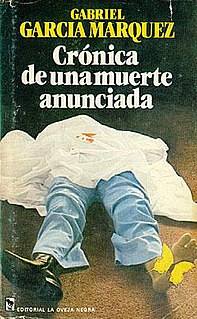
Chronicle of a Death Foretold is a novella by Gabriel García Márquez, published in 1981. It tells, in the form of a pseudo-journalistic reconstruction, the story of the murder of Santiago Nasar by the Vicario twins.

The Good Soldier: A Tale of Passion is a 1915 novel by the British writer Ford Madox Ford. It is set just before World War I, and chronicles the tragedy of Edward Ashburnham, the soldier to whom the title refers, and his seemingly perfect marriage, along with that of his two American friends. The novel is told using a series of flashbacks in non-chronological order, a literary technique that formed part of Ford's pioneering view of literary impressionism. Ford employs the device of the unreliable narrator to great effect, as the main character gradually reveals a version of events that is quite different from what the introduction leads the reader to believe. The novel was loosely based on two incidents of adultery and on Ford's messy personal life.

Oroonoko: or, the Royal Slave is a work of prose fiction by Aphra Behn (1640–1689), published in 1688 by William Canning and reissued with two other fictions later that year. It was also adapted into a play. The eponymous hero is an African prince from Coramantien who is tricked into slavery and sold to European colonists in Surinam where he meets the narrator. Behn's text is a first-person account of Oroonoko's life, love, rebellion, and execution. Oroonoko: or, the Royal Slave “centers on the unlucky love story of Oroonoko, an African prince, and the beautiful Imoinda.”

Balzac and the Little Chinese Seamstress is a semi-autobiographical novella written by Dai Sijie, and published in 2000 in French and in English in 2001. A film based on his novel directed by Dai was released in 2002.
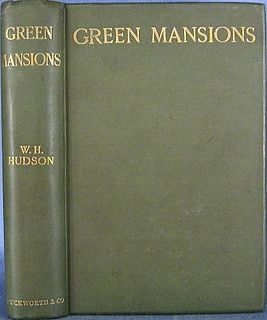
Green Mansions: A Romance of the Tropical Forest (1904) is an exotic romance by William Henry Hudson about a traveller to the Guyana jungle of southeastern Venezuela and his encounter with a forest-dwelling girl named Rima.

Lotte in Weimar: The Beloved Returns, otherwise known as Lotte in Weimar or The Beloved Returns, is a 1939 novel by Thomas Mann. It is a story written in the shadow of Johann Wolfgang von Goethe; Mann developed the narrative almost as a response to Goethe's novel The Sorrows of Young Werther, which is more than 150 years older than Lotte in Weimar. Lotte in Weimar was first published in English in 1940.

Generals Die in Bed is an anti-war novella by the Canadian writer Charles Yale Harrison. Based on the author's own experiences in combat, it tells the story of a young soldier fighting in the trenches of World War I. It was first published in 1930 by William Morrow.
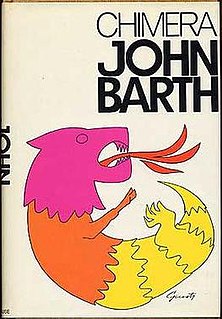
Chimera is a 1972 fantasy novel written by American writer John Barth, composed of three loosely connected novellas. The novellas are Dunyazadiad, Perseid and Bellerophoniad, whose titles refer eponymously to the mythical characters Dunyazad, Perseus and Bellerophon. The book is an example of postmodernism, which can be seen in its metafictional content and its incorporation of stylistic elements that go beyond the traditional novel genre. It shared the U.S. National Book Award for Fiction with Augustus by John Edward Williams.
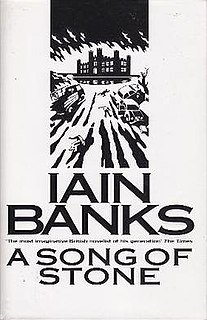
A Song of Stone is a novel by Scottish writer Iain Banks, published in 1997.

Maarten 't Hart is a Dutch writer. Trained as a biologist in zoology and ethology at the Leiden University, he taught that subject before becoming a full-time writer in the 1980s, having made his debut as a novelist in 1971 under the name Martin Hart with Stenen voor een ransuil.
The Wedding of Zein is an Arabic novella by the late Sudanese author Tayeb Salih. It was partially published in Arabic in 1964, fully published in 1966 and translated into English in 1968. Within the realm of Arabic literature, the book is considered a classic and was republished as part of the influential Heinemann African Writers Series.
"The Beach of Falesá" is a novella by Scottish author Robert Louis Stevenson. It was first published in the Illustrated London News in 1892, and later published in book form in the short-story collection Island Nights' Entertainments (1893). It was written after Stevenson moved to the South Seas island of Samoa just a few years before he died there.

Random Acts of Heroic Love (2007) is a semi-autobiographical debut novel by the author and actor Danny Scheinmann. It follows the parallel stories of two unconsciously connected men in two different time eras motivated by the memory of love: Moritz Daniecki, a young Austro-Hungarian soldier captured by the Russians during the First World War and sent to a POW camp in Siberia, who decides to escape in 1917 and walk thousands of miles for the sake of his childhood sweetheart Lotte; and Leo Deakin, who loses his beloved girlfriend Eleni in a bus crash in Ecuador in 1992, and in his despair embarks on his own journey of discovery and self-reconciliation.

Novelas ejemplares is a series of twelve novellas that follow the model established in Italy. The series was written by Miguel de Cervantes between 1590 and 1612 and printed in Madrid in 1613 by Juan de la Cuesta. Novelas ejemplares followed the publication of the first part of Don Quixote. The novelas were well received.

Amok is a novella by the Austrian author Stefan Zweig. First printed in the newspaper Neue Freie Presse in 1922, Amok appeared shortly afterwards in the collection of novellas Amok: Novellas of a Passion. As Zweig was fascinated and influenced by Sigmund Freud’s work, Amok includes clear psychoanalytic elements. It deals with an extreme obsession, which leads the protagonist to sacrifice his professional and private life and, eventually, to commit suicide.
The Diothas; or, A Far Look Ahead is a 1883 utopian novel written by John Macnie and published using the pseudonym "Ismar Thiusen". The Diothas has been called "perhaps the second most important American nineteenth-century ideal society" after Edward Bellamy's Looking Backward (1888).
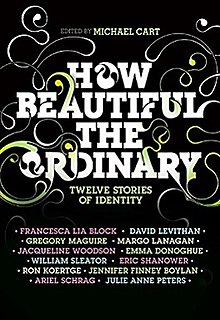
How Beautiful the Ordinary: Twelve Stories of Identity is an anthology of LGBTQ short stories for young adults edited by American author Michael Cart. It was first published in 2009. The anthology contains an introduction by Cart, 11 short stories, and one novella by acclaimed lesbian and gay authors.

Graziella is an 1852 novel by the French author Alphonse de Lamartine. It tells of a young French man who falls for a fisherman's granddaughter – the eponymous Graziella – during a trip to Naples, Italy; they are separated when he must return to France, and she soon dies. Based on the author's experiences with a tobacco-leaf folder while in Naples in the early 1810s, Graziella was first written as a journal and intended to serve as commentary for Lamartine's poem "Le Premier Regret".
















